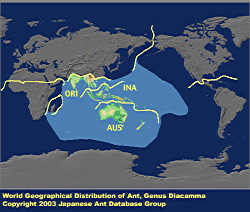
|
genus
|
Diacamma
|
 |
Japanese Name
|
Toge-oo-hari-ari-zoku
|
Original Reference
|
|
Mayr, G. (1862) Myrmecologische Studien. Verhandlungen der k. k. ZoologischBotanischen Gesellschaft in Wien 12: 649-776.
|
Description
|
|
Relatively large ants. Body color black to dark gray with metallic blue or purple reflections in some species. Head oval, with triangularly-produced anterior clypeal margin. Eyes large and distinct, situated almost at the middles of the sides of the head. Antennae 12-segmented; scape long, exceeding posterior margin of head; funiculus filiform, without club. Promesonotal suture distinct. small bowl-like depression present on each side of trunk between mesonotum and mesopleuron. Petiole large with paired dorsal projections, usually spines. Head, trunk and petiole always boldly and distinctively striate, parts of gaster nearly as strongly striate as trunk in most species.
|
|

|
Remarks
|
|
Generally nesting in soil. Winged reproductive females are not known. Males are yellowish-brown to reddish brown and winged. Diacamma is distributed in the Indo-Australian region, and includes around 10 described species. Current species-level taxonomy of the genus is considered unsound.
|
Editor
|
|
Original text by Masao Kubota. English translation by Kazuo Ogata, edited by Robert W. Taylor.
|
|